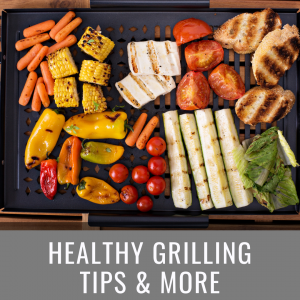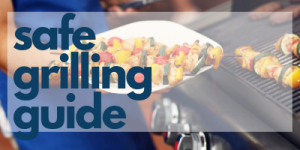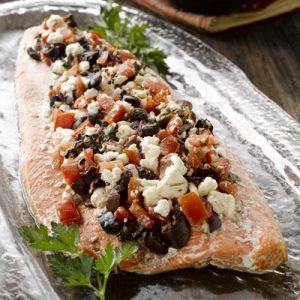During the summer, if there is one thing I enjoy more than spending time in the water it has to be grilling! The simplicity, the flavor, the variety, the company, and of course the food that is served from my grill not only nourishes my family and friends but also helps create memories everyone will cherish. With the right education, preparation, and planning the grill can be the perfect place to cook up a healthy meal that everyone can enjoy. This month I am sharing with you a healthy twist on your favorite grill classics. I hope you enjoy!
- Stephanie
|
|
|
6 Tips for a Healthier Grill
|
1. Choose lean alternatives. Venture out of your comfort zone, and grill up nontraditional forms of meat, such as buffalo, ostrich, venison (deer), pheasant, and quail. buffalo, ostrich, venison (deer), pheasant, and quail.
Quick Reference Guide for Lean Cooking:
- Poultry: Skinless, white meat chicken or turkey; ground turkey breast
- Beef: Flank steak, top loin, sirloin, tenderloin; 93% lean (or higher) ground beef
- Veal: Any trimmed cut
- Pork: Pork chops or tenderloin
-
2. Portion it out. One pound of ground meat should make 4 burgers; this guide helps to keep portion sizes in check. A serving of meat should be 3-4 oz, about the size of a deck of cards.
3. Skip the processed meats. Grilled hot dogs and sausage, even the lean varieties, such as turkey hot dogs or chicken sausage, contain cancer-causing substances from the preservation techniques used. The American Institute for Cancer Research has linked processed meats to an increase in colorectal cancer. If hot dogs are a must, consider using a nitrate-free variety such as Applegate Farms.
4. Marinate your meat. The American Institute for Cancer Research recommends marinating meat for at least 30 minutes to help reduce cancer risk. Scientists are unsure why, but it appears that the marinade acts as a barrier to protect against carcinogens. Skinless chicken marinated in pineapple juice and soy sauce makes for an easy-to-prepare meal that you will enjoy!
5. Switch up your side dish. Potato salad, coleslaw, and macaroni salads are all popular BBQ foods; however, many times these are laden with full-fat mayonnaise. Instead, use fat-free yogurt for half of the mayonnaise in the recipe to reduce total calorie and fat intake. Here are a few more nutrient dense side dishes that are great for any BBQ get-together!
- Serve beans as a side dish for a fiber boost!
- Fresh vegetable and fruit trays provide vitamins and minerals as well as fiber to keep you and your guests from overeating.
Grill some vegetables in aluminum foil packages:
- Onion sliced into 1/2-inch rounds.
- Corn on the cob.
- Mushrooms. Grill portobello mushrooms like burgers, or them cut into thick slices; grill small mushrooms strung on a skewer or kabob.
- Eggplant, cut lengthwise into 1/4-inch slices.
- Zucchini cut lengthwise into 1/4-inch slices.
- Asparagus spears. (Simple and easy, you can just grill whole spears.)
6. Clean the grill. Scrape down and scrub the grill after every use to help remove the carcinogenic residue that can build up. |
|
|
Safe Grilling Tips
|
 Whether you fire up the grill for weekend entertaining or use it each night, think of your grill as an extension of your kitchen. Follow the same food safety steps both inside and out.
Start clean:
- Whether you are using your own grill or a public grill at a park or campground, scrub it with hot, soapy water before each use.
- Wash your hands before, during and after food preparation. Since bacteria can easily transfer from the body to foods and surfaces, wash your hands thoroughly after switching tasks. This is especially important after handling raw meat. Pack moist towelettes or a hand sanitizer in your cooler for when soap and water are not readily available.
Safely thaw and marinate meat:
- Thaw frozen foods in the refrigerator or microwave, not on the countertop or by the grill.
- Marinate meat in the refrigerator.
- Never use the same brush to baste raw and cooked meat. Wash brushes in hot, soapy water between uses.
- Boil any leftover marinade before, using it to season cooked meat.
Don't shareware:
- Use separate cutting boards, plates, and grilling utensils when handling raw meat and ready-to-eat foods.
- Color-code them to easily separate items used with raw foods.
- After using knives, grilling tongs, or forks with raw meat and poultry, clean them thoroughly with hot soapy water.
Cook it right:
- Grilled foods can be harmful if not fully cooked. The only reliable way to ensure the meat is safe and ready to eat is by using a meat thermometer. Checking the color of meat or juices does not work.
- Use the following internal temperature guide:
- Steak: 145°F (Allow to rest for 3 minutes before carving or consuming)
- Hamburgers: 160°
- Chicken: 165°
Watch the clock:
- Don't leave food unrefrigerated for extended periods of time, even if it’s fully cooked.
- Put all the dishes in the refrigerator within two hours. In hot weather (90° F or warmer), this time is reduced to one hour. Set out perishable food items in one-hour shifts. After each shift, place uneaten food back in a refrigerator set below 40° F.
- Lengthen the staying power of perishable foods by keeping them on ice. Keep a refrigerator thermometer on hand to make sure foods stay chilled properly in the cooler or refrigerator.
Let leftovers go:
- Store leftovers in shallow, airtight containers (two inches deep or less). Write the date on top.
- Leftover grilled foods have a refrigerator life of three to four days. If you don't finish a leftover within this time frame, toss it.
- Reheat leftovers to an internal temperature of 165° F before serving a second time around. Check the temperature with a meat thermometer. Boil leftover sauces before reusing them on cooked meat. Reproduced with the permission of The Academy of Nutrition and Dietetics (www.eatright.org)
|
|
Featured Recipe
Greek Grilled Salmon
|
Recipe from Alaska Gold
Grilled Alaska Salmon:
- 1 Alaska Gold™ Coho Salmon side (~2.25 pounds)
- Heavy-duty aluminum foil (18-inches wide)
- High-heat cooking spray
- Oil (olive, canola or grapeseed)
Greek Seasoning:
- 1/2 cup each feta cheese and chopped Roma tomatoes
- 1/4 cup chopped olives
- 1 Tablespoon each chopped fresh oregano and thyme
- Sea salt and pepper, to taste
Heat grill to medium-high (400°F). Spray-coat dull side of aluminum foil (18-inch wide sheet, cut 4” longer than salmon side). Rinse any ice glaze from Alaska Salmon under cold water; pat dry with a paper towel. Brush both sides of Alaska salmon with oil and place on foil (skin side down). Bring long sides of foil together and fold over several times to seal; roll up short ends to form a packet. Place packet, seam side down, onto grill grate and cook 8 to 10 minutes.
Remove packet from grill, open, and add Greek seasoning. Crimp loosely to close, and return to grill (seam side up). Cook an additional 8 to 10 minutes, just until fish is opaque throughout. |
|
|
Be Inspired
|
|
"You don’t have to cook fancy or complicated masterpieces – just good food from fresh ingredients."
– Julia Child
|
|
|
About SO Nutrition
|
 Stephanie Leipprandt Ouellette, MBA, RDN, LD
Stephanie Leipprandt Ouellette, MBA, RDN, LD Stephanie has been working in the field of nutrition and dietetics since 1995. She earned a Bachelor of Science degree in Dietetics from Michigan State University, completed an Approved Pre-Professional Practice Program at Western Michigan University and earned a Master of Business Administration from Baker College. She’s been a Registered Dietitian Nutritionist since 1996 and licensed in Texas since 2007. In 2008, Stephanie earned her certification in Childhood and Adolescent Weight Management. Stephanie has extensive clinical & managerial experience, both in corporate settings and in the community. Now she wants to share her knowledge with you, because most (if not all) nutritional habits begin at home.
Stephanie and her family reside in Katy, Texas
|
|
| |
Copyright © 2019 Customized Nutrition Newsletters, All rights reserved.
|
|
| |
|
|